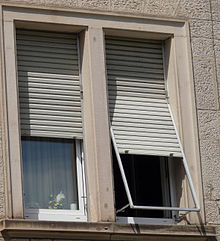Roller shutter
This article needs additional citations for verification. (September 2015) |


A roller shutter, security shutter, coiling door, roller door or sectional overhead door is a type of door or window shutter consisting of many horizontal slats (or sometimes bars or web systems) hinged together. The door is raised to open it and lowered to close it. On large doors, the action may be motorized. It provides protection against wind, rain, fire and theft. In shutter form, it is used in front of a window and protects the window from vandalism and burglary attempts.
Applications[]
Roller shutters have many applications including doors for vans, garages, kitchens, schools, prisons and warehouses. They are also commonly used as window blinds in some European countries, such as Germany and Spain.
In some parts of the world, roller shutters are subsidized by local governments. In areas that are frequently exposed to inclement weather, roller shutters are used as a method of insulation, can protect windows against hail damage, and can be made to withstand high wind.
In some municipalities, building owners may have to request a permit or are disallowed from having certain types of roller shutters on the exterior of their building. The cost of these systems can be significant, with the cost being upwards of $25,000-40,000.[clarification needed] Plywood boards can also act as a similar deterrent to theft and burglary.[1]
Common Problems with Roller Shutters[]
Roller Shutters are important for any premises and smooth working of a roller shutter is necessary for the safety and security of any premises. There are some common problems that can cause serious issues with Roller Shutters if they are not handled properly. Here are some common problems: Failed Motor: A defective motor can cause serious problems with roller shutters. If there is any unnecessary noise in the motor then it means there is something wrong with the motor and that should be fixed on priority. A malfunctioned motor can also get overheated and this can affect roller shutter working.[2]
Power Sources and Connections: In an electric roller shutter, issues with power sources are the most common problems one can face. So it's always better to check the power sources and connections regularly. Loose connections can cause serious damage to the roller shutter and sometimes it may cause for short circuit or any other faults.
Dust or Obstruction in the Track: Dust or obstruction in the roller shutter track is also a common problem that can cause roller shutter failure. If a roller shutter is moving slowly or has irregular movements, then it might be possible there is an obstruction or dust in the track. One should clean it immediately for the smooth functioning of a roller shutter.
Proximity Sensors: These sensors control the opening and closing of the roller shutters. If there is dirt on the sensor it will not work properly and can affect the opening or closing of the shutter. Sometimes it can also damage the roller shutter. Proximity Sensors can also be damaged due to any reason so one should check these sensors regularly.
Types and operation[]
This section does not cite any sources. (December 2017) |
- Built-on roller shutter door
- Describes the type where the roller shutter box is fixed to the exterior of the building facade.
- Built-in roller shutter doors
- Where the roller shutter box is built into the lintel above the window.
- Integrated roller shutter
- A roller shutter and window combined as a single unit.
- Roller shutter with tilting louvres
- A roller shutter with laths that tilt, similar to an external venetian blind.
- Manual
- With gear drive from the shutter roller traced through the building facade to a universal joint on the room side that is operated by a cranked winding handle.
- Manual tape
- A tape drive around a flange on the roller is traced through the building facade with pulley guides to an inertia reel on the room side:
- Spring Assist
- Spring assist roller shutters are operated by manually lowering or lifting the handle which is mounted to the curtain end slat. Most cost effective solutions for securing small spaces.
- Motorized / Electric
- With a tubular motor fitted within the roller axle tube. Automatic operation can be added. Controlled with a smartphone, remote or hardwired switch.
Components[]
- Slats
- Extruded or roll formed steel, aluminium or stainless steel. Single or multi wall. Hollow or insulated designs.
- Roller (or axle tube)
- Steel, aluminium tube supported at either end by an end plate.
- Shutter box
- Formed steel or aluminium extrusion box designed to protect shutter’s internal components.[citation needed]
- Shutter spring
- Spring wire. Made from the spring wire, it also called torsion spring.
- Flat spring. Formed by hardened and tempered steel strips in coils. Common steel grades C67, CK67, SAE1070, etc.
- Guide rail (or track)
- Steel or aluminium to retain the shutter curtain within the opening. Weather sealed to increase product lifetime and reduce operating vibration.
- Bottom slat
- Steel, aluminium or PVC to match the rest of the roller shutter curtain. Safety edge or rubber weather seal to reduce draught can be added.
- Lock
- Important part of roller shutter used to manually secure the curtain slats in place. Can be locked with slide lock and bullet lock. Slim key locks are installed within the end slat and have bars that securely lock shutter into the guide rails.
References[]
- ^ "Minneapolis businesses rush to install security shutters after city changes rules to allow them". Star Tribune. Retrieved 2021-03-22.
- ^ "Common problems with Roller Shutters". 24 Shutter Repair. Retrieved 2021-08-25.
See also[]
- Roller blind
- Roll-down curtain
- Doors
- Windows